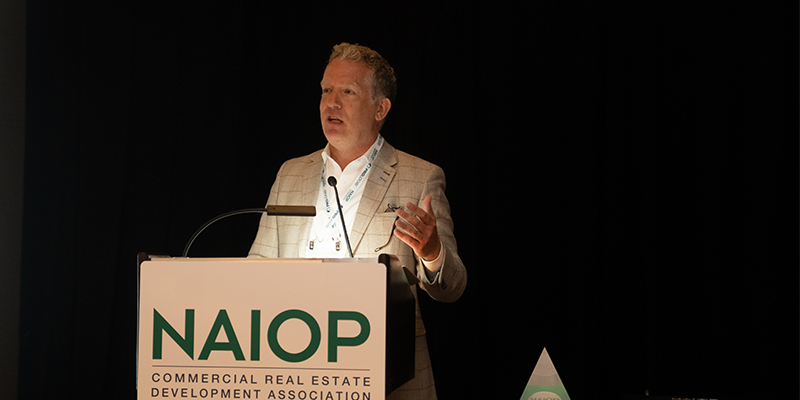The ideal industrial real estate site criteria have evolved with the economy.
“It’s power, power, power instead of location, location, location,” said Damon Austin, managing director, global head of customer led development, Prologis. “Power from a logistics perspective, it really is more critical than ever.”
Experts who joined Austin on a panel discussing industrial real estate development trends at NAIOP’s CRE.Converge conference this week agreed. Denice Tokunaga, partner, Seyfarth Shaw LLP, moderated the conversation joined by Adam Mullen, CEO, KBC Advisors; Greg Pearson, managing director, Fortress Investment Group; and Reon Roski, CEO, Majestic Realty Co.
Pearson said proximity to power capacity is the next frontier of leasing.
“Everyone in this room, I’m sure has been inundated with tenants saying, ‘How much power do you have?’ We have all grappled with the pain, the suffering of dealing with public utilities and trying to procure that power. I would say our biggest risk that keeps me up at night is how do we protect our power?”
He added that this means holding onto vacant buildings with power potential.
“In a high interest rate environment, losing power will kill you,” Pearson said. “I encourage everyone, if you have a vacant building, protect it at all costs, because if you lose that power, you’re just done.”
Data centers are among the most amp-hungry tenants. Austin said there are plenty of investors eager to get in on the lucrative projects.
“We look at projects frequently that are half-billion, billion-dollar-plus single assets,” Austin said. “There’s a ton of money that wants to be involved in data center development, and we haven’t yet really developed that core takeout capital pool. We don’t really know where these half-trillion-dollar assets are going to sit long term.”
Roski said there’s even speculation that entreprenuers like Elon Musk may take the data centers out of this world on a spaceward mission to tap solar power directly.
“Then who are you going to sell it to? I mean it’s a big risk with data [centers]. We do them, but we think twice about, how long is the lease… And whose dollars are going into developing that building. Is it the tenant’s dollars, or is it our landlord dollars?”
Other evolving trends the panel discussed included warehouse location diversification, environmental commitments, automation, and manufacturing shifts from sites overseas to neighbors like Mexico and Canada.
Roski said she sees warehouse space growing outside core markets in places like Texas, Arizona and Nevada.
“I think Vegas is our hottest market,” she said. “We barely start building a building and it’s getting leased.”
But some places are slowing down.
“It’s just showing the migration of the people, and the warehouses are following them,” Roski said. “Before the COVID-19 pandemic, they might have two warehouses… one warehouse on the East Coast and one on the West Coast. But now it seems like the pandemic changed the metrics of it all, and companies want facilities within 24 hours delivery of their customers.”
Mullen said part of that demand is fueled by e-commerce, where “consumer impatience continues to grow.” Add to that companies’ desire to better serve customers and an unexpectedly resilient capacity to spend.
Roski said she can see growth in e-commerce continuing.
“How can it not?” she said with a laugh. “Even my 85-year-old father can order things on Amazon now.”
Austin said growth isn’t as brisk as it once was. The industry is coming out of a 14-year bull run with muted demand from much of the customer base. But things are looking up.
“I think the bright spot from the growth perspective is that [e-commerce] is back,” Austin said. “We’re seeing that from the largest e-commerce occupiers across the globe.”
Pearson expects that growth to continue, explaining that looking at data from the last couple of months shows that a lot of downstream retailers are starting to build inventories. “A lot of that is beyond the scope of the holidays, which is encouraging as we go into the next year.”
Pearson also predicted Europe’s insistence on environmental certification for buildings is coming to the states. As companies build, he suggested they focus on getting their credentials in order, even for warehouses.
“You’re going to see many of these buyers say if it doesn’t have the credentials, I don’t want to look at it,” he said.
As environmental regulations come online, Pearson said some are coming up with novel solutions.
“Ironically, one of our tenants said the best way for him to circumvent EV regulations is rail. It’s like to get away from 2024, I’m going to go back in time to 1924, and we’re seeing these tenants saying, ‘I need rail because I’m just going to pull the cans out of the port on rail,’ because that is regulated differently.”
As some go to the past, others are looking to the future with automation. Mullen said labor is still important even as automation moves forward.
“The more automation you can put in, the less dependency on labor,” he said. “It’s not getting labor out of the building entirely, but it’s a different skill set that’s going to be required… but this whole conversation seems like it’s going to keep coming back to power, because automation requires power.”
This post is brought to you by JLL, the social media and conference blog sponsor of NAIOP’s CRE.Converge 2024. Learn more about JLL at www.us.jll.com or www.jll.ca.









